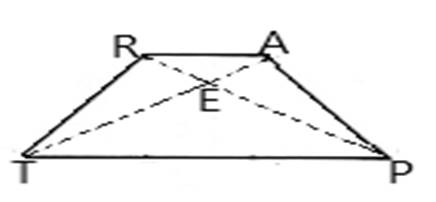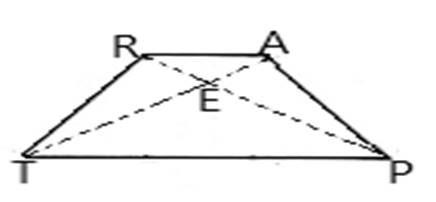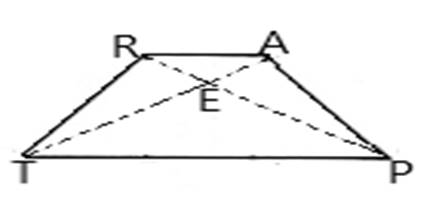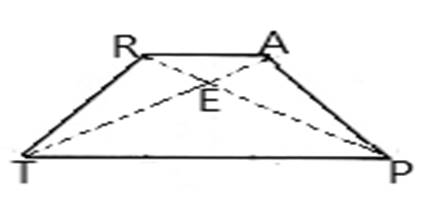
a.
To find:The statement opposite sides of an isosceles trapezoid RTPAare congruent is true.
a.
Answer to Problem 3PSA
The statementopposite sides are congruent is false.
Explanation of Solution
Given information:
An isosceles trapezoidRTPA with sides RT, TP, PA and RA.
Diagonals oftrapezoid RTPA are RP and TA.

In any isosceles trapezoid, two opposite sides (the bases) are parallel, and the two other sides (the legs) are of equal lengths. The diagonals are of equal length. Only legs are congruent but bases are not congruent. Hence, the statement is false.
b.
To find: The statement opposite sides of an isosceles trapezoid RTPA are parallel is true.
b.
Answer to Problem 3PSA
The statement opposite sides are parallel is false.
Explanation of Solution
Given information:
An isosceles trapezoid RTPA with sides RT, TP, PA and RA.
Diagonals of trapezoid RTPA are RP and TA.

In any isosceles trapezoid, two opposite sides (the bases) are parallel, and the two other sides (the legs) are of equal lengths. The diagonals are of equal length. Only bases are parallel but legs are not parallel. Hence, the statement is false.
c.
To find:The statement diagonalsRP and TAof an isosceles trapezoid RTPAbisect the anglesis true.
c.
Answer to Problem 3PSA
The statement diagonals RP and TA bisect the
Explanation of Solution
Given information:
An isosceles trapezoid RTPA with sides RT, TP, PA and RA.
Diagonals of trapezoid RTPA are RP and TA.

A diagonal doesn’t bisect angles in an isosceles trapezoid. It only happens in a square or a rhombus as there the length and breadth, both are equal.
d.
To find:The statement diagonals RP and TA of an isosceles trapezoid RTPA bisect each otheris true.
d.
Answer to Problem 3PSA
The statement diagonals RP and TA bisect each other is false.
Explanation of Solution
Given information:
An isosceles trapezoid RTPA with sides RT, TP, PA and RA.
Diagonals of trapezoid RTPA are RP and TA.

Isosceles trapezium is a trapezium whose non parallel sides are equal. If we have a quadrilateral whose diagonals bisect each other then it happens to be parallelogram. Every parallelogram is a trapezium but every trapezium is not parallelogram.
e.
To find:The statementdiagonals RP and TA of an isosceles trapezoid RTPAare congruentis true.
e.
Answer to Problem 3PSA
The statement diagonals RP and TAare congruent is true.
Explanation of Solution
Given information:
An isosceles trapezoid RTPA with sides RT, TP, PA and RA.
Diagonals of trapezoid RTPA are RP and TA.

The diagonals of an isosceles trapezoid are also congruent, but they do not bisect each other. Isosceles trapezoid diagonals theorem states that “The diagonals of an isosceles trapezoid are congruent.
Chapter 5 Solutions
Geometry For Enjoyment And Challenge
Additional Math Textbook Solutions
A Survey of Mathematics with Applications (10th Edition) - Standalone book
Finite Mathematics for Business, Economics, Life Sciences and Social Sciences
Calculus for Business, Economics, Life Sciences, and Social Sciences (14th Edition)
Precalculus (10th Edition)
Using and Understanding Mathematics: A Quantitative Reasoning Approach (6th Edition)
Essentials of Statistics, Books a la Carte Edition (5th Edition)
 Elementary Geometry For College Students, 7eGeometryISBN:9781337614085Author:Alexander, Daniel C.; Koeberlein, Geralyn M.Publisher:Cengage,
Elementary Geometry For College Students, 7eGeometryISBN:9781337614085Author:Alexander, Daniel C.; Koeberlein, Geralyn M.Publisher:Cengage, Elementary Geometry for College StudentsGeometryISBN:9781285195698Author:Daniel C. Alexander, Geralyn M. KoeberleinPublisher:Cengage Learning
Elementary Geometry for College StudentsGeometryISBN:9781285195698Author:Daniel C. Alexander, Geralyn M. KoeberleinPublisher:Cengage Learning

